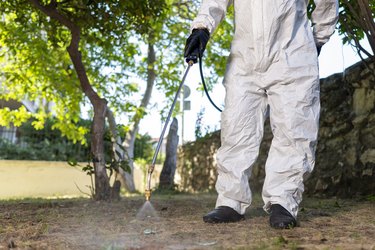
Having winged bugs in the house is always annoying, but in some cases, it can be a sign of a severe problem. The bugs could be fruit flies, mosquitos or pests like carpenter ants or termites. The latter two can cause significant damage to your home, and they share a unique trait: They shed their wings after mating.
How Do Termites Lose Wings?
Video of the Day
The termite life cycle starts when swarming, winged reproductive females and males leave their established colonies to start procreating. Once fertilization occurs, the wings are no longer needed, so termites get rid of them. They either eat them or arch their back, making the wings fall off. These termites go on to become queens and kings of newly established colonies. The queens lay the eggs, which then hatch into white pale larvae.
Video of the Day
The larvae develop into soldiers, workers and primary or secondary reproductive termites known as nymphs. At this stage, they develop soft exoskeletons beneath their outer hard exoskeletons.
Once termites reach maturity, the outermost skeletons open to reveal the exoskeletons beneath them. This opening is an ongoing process throughout the termite life cycle. The workers build mud tunnels and chambers in moist areas, like bathrooms and crawl spaces, and around framing cracks. Termites also live in and eat vulnerable wood.
Black Bugs With Wings
Termites are usually about 1/4 to 3/8 of an inch long, and the workers are light in color most of the time. The winged ones can share that lighter color, but they can also be dark brown or black depending on the species you're dealing with. They have a wide body without a noticeable waist, transparent wings in the front and back that are the same length and straight antennae.
Flying carpenter ants can also be black or brown, but some have more of a reddish hue. They have longer segmented bodies (like other ants) and two sets of brownish wings in different sizes. Their antennae are bent, resembling elbows.
After mating, female carpenter ants lose their wings, and the males die. Their life cycle also starts with a mating swarm and new colony establishments. While these insects do not eat wood, they chew through it when building their tunnels.
More About Termites and Carpenter Ants
If you have house bugs with wings that fit either of those descriptions, it is better to take action before they start swarming or causing damage to your property. While termites do not bite humans, carpenter ants will when their colonies are disturbed. The bites can be painful because these ants squirt out formic acid when they bite.
The signs of a termite infestation include holes in your drywall the size of a pinpoint; discolored, drooping drywall; squeaky or buckling wood and laminate flooring; damaged wood and peeling paint that looks like water damage. You might also see mazelike patterns on your walls, floors and furniture; mud tubes on your home's foundation and piles of discarded wings. These wings look like fish scales.
Carpenter ants can leave similar clues for you to find, including piles of shed wings around your vents, baseboards and window sills. You might also see sawdust or wood shavings under wooden areas, like baseboards; hear rustling noises behind your walls or see the ants or termites creeping or flying about. Those ants usually don't cause as much damage as termites, but it can still run you thousands upon thousands of dollars to get rid of them and repair the damage.